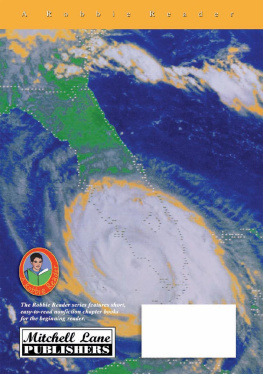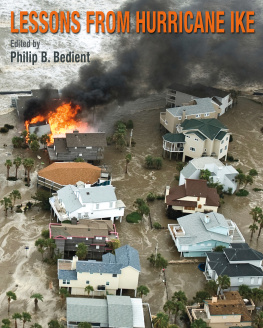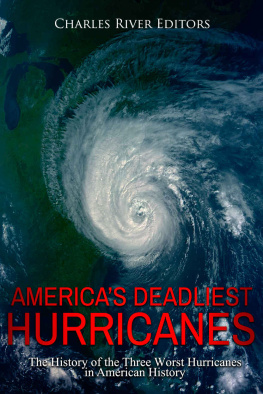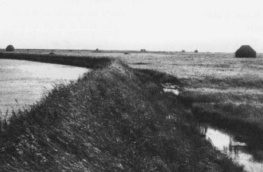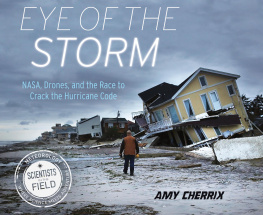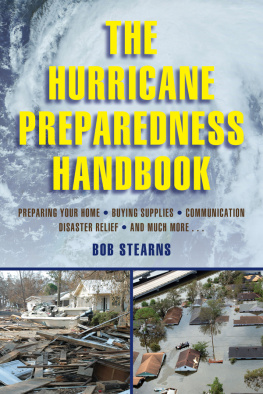

CONTENTS
ACKNOWLEDGMENTS
I N MY NEARLY forty years of study and experience in the field of meteorology, specializing for the past thirty-six years in the study and forecasting of hurricanes, many individuals have contributed directly or indirectly to the material presented in this book. First and foremost would be my teacher and friend Professor Yoshikazu Sasaki at the University of Oklahoma; Dr. Robert Cecil Gentry, who gave me my start at the National Hurricane Research Laboratory; and Dr. Neil L. Frank, under whom I served at the National Hurricane Center. Others include Dr. Robert H. Simpson and the late Gordon E. Dunn, former directors of the National Hurricane Center; professors Noel E. LaSuer of Florida State University and William Gray of Colorado State University; along with several hurricane forecasters, including Raymond Kraft, Gil Clark, John Hope, and Paul Hebert with whom I have enjoyed many exchanges and from whom I learned much. Some specific material for this book was provided by Dr. Frank Marks and Dr. Hugh Willoughby of NOAAs Hurricane Research Division; Richard Decker of NOAAs Aircraft Operations Center; and others too numerous to mention individually.
Also, I wish to acknowledge the numerous Hurricane Hunter crews and technicians from NOAA and its predecessors the U.S. Air Force and Navy with whom I had the pleasure of flying over a period of sixteen years; and the numerous Local, State, and Federal Emergency Managers with whom I had the pleasure of working over many years in an effort to protect life and property when hurricanes threatened. I would also like to thank the individuals and families who shared the personal Hurricane Andrew experiences with me that I related in this book so that others may learn from them.
Finally, I wish to thank my spouse, Mary Jane, and my children, Mark, Robin and Kimberly, for the sacrifices that they have made over the years to support my career, and for enduring my numerous absences from family activities associated with my various positions of responsibility that are partially related in this book.
Dr. Bob Sheets
Growing up in Florida in the 1940s and 1950s, when every year seemed to bring hurricanes, planted the seeds of my fascination with what I later learned are the worlds deadliest storms. My interest blossomed during the 1980s and 1990s when, as weather editor of USA TODAY, I reported on hurricanes, sometimes from the National Hurricane Center and a few times from airplanes inside hurricanes. When I began thinking about a book on hurricanes, I realized that I wanted Bob Sheets to join me as an author. Bob is not only an experienced hurricane forecaster and scientist, but is skilled at communicating his work to nonscientists. Perhaps even more important, in August 1992 I spent four days as a reporter at the National Hurricane Center during Hurricane Andrew. Before, during and after the early morning hours when Andrew damaged Bobs home and destroyed the homes of some of his colleagues, Bob stayed calm, clearly explaining the storm during one live television interview after another, while making forecasting decisions that could have meant life or death for hundreds of Americans. I concluded that anyone who could stay so cool during Hurricane Andrew was ready for the challenge of working with a journalist on a book.
Bob more than lived up to my expectations, never losing his patience as he led me to a deeper understanding of the science and history of hurricanes. I want to acknowledge the many others who have taught me about hurricanes over the years, going back to my first visit to the Hurricane Center in the early 1980s. They include forecasters, research scientists, and crew members I was privileged to meet on hurricane flights. I want to especially thank Bob and Joanne Simpson, who shared their memories of the creation of modern hurricane science; Bill Gray, who helped me see how hurricanes and other tropical cyclones fit into the global climate picture; and Hugh Willoughby, who doesnt let his job as head of the governments hurricane research program get in the way of his wit and way with words.
I want to offer special thanks to Mike Bryan, who led this book back to the light after I had let all of the information that Bob and I had collected bury the story we had to tell. J. Edward Kastenmeier, our Vintage Books editor, is one of those rare editors who closely examines every word, raising questions an author might find tiresome at the time, but which he later appreciates. I want to thank our agent, Joe Spieler, for making the business side of the book work well.
Finally, without the love and encouragement of my wife, Darlene, I would be able to accomplish little. Being able to share any success we might enjoy with her makes all of the work worthwhile.
Jack Williams
PREFACE
I N THE WHISPERING PINES neighborhood about twenty miles southwest of downtown Miami, Tom Ochmanski and his wife, Laurie, have put their one-year old son, Ryan, and two-year-old daughter, Caitlyn, to bed early in the evening. Whispering Pines is not in an evacuation zone and the Ochmanski house is a strong one they think. Around midnight, Tom and Laurie and Lauries mother, Lee Bolander, finally try to get some rest, but the howling winds wake them two hours later. As the adults sit in the living room, watching reports on their battery-operated television set, squalls of heavy rain and high winds became stronger and more and more frequent. By 4:45 a.m., winds are probably gusting to over 150 or 160 mph, and debris slamming into the house creates an almost deafening roar. Above this roar, parents and grandmother hear breaking glass in Ryans bedroom. Tom rushes in to find the window shattered by flying debris and scattered around the room, but, remarkably, Ryan is not cut or hurt. Tom grabs him and Laurie gets Caitlyn from her bedroom and the entire family huddles in the living room, close to the hallway entrance. They hear the other windows breaking on the north end of the house. As Hurricane Andrews eye wall moves directly over them, the screaming wind becomes even more terrifying. The Ochmanskis know when the wind shifts direction because the loud thumps of striking debris now come from the east side of the house.
Tom shines a large flashlight at the top of the front wall and sees it pulling away from the ceiling. This is a reinforced concrete tie beam connecting the walls to the roof, and these winds are doing their best to lift it right off the house. The family moves closer to the hallway door and starts praying. Suddenly, and with a tremendous crash, the entire front of their house slams inward, while the front half of the roof is ripped away. A large blunt object strikes Tom in the back, knocking him across the room. Laurie quickly crawls through the debris to the hallway, taking the two terrified children with her. She places Ryan and Caitlyn on shelves in the linen closet off the hallway and crouches in the open doorway to protect them with her own body.
Where is Tom now? Where is her mother? Are they alive or dead? Laurie has only her fears and her prayers.
Great tropical cyclones are the largest and most destructive storms on the face of this planet; collective memory never forgets the passage of a powerful, deadly storm, such as Hurricane Andrew in South Florida in 1992. In the past, these typhoons and hurricanes struck without warning. Today, this never happens. We can forecast the great storms with increasing, often remarkable, accuracy. We can save lives and property some lives, some property. However, we will never be able to stop these storms. The residents of shorelines of the world exposed to storms from the tropics, and the tourists who flock to these sandy paradises will always prick their ears when they hear the words, A hurricane watch has been posted for....
Next page


